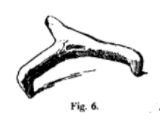




Stilts are small supports used when firing glazed ceramics to stop the melting glaze from fusing them to each other or the kiln.[1][2][3] Stilts are a form of kiln furniture.[4] Their presence in archaeological sites, where they may be known as pernette, along with other kiln furniture such as saggars and kiln bars can be used to support a case for local production.[4] Some potters avoid the need for stilts by not glazing the bottom of their products.[5] This is known as dry footing.[5]
Various types of stilts have been developed over the centuries:
The tripod stilt, which has three legs with a raised point on each end, appears to have been developed in China at least as far back as the third century AD.[2][6] Tripod stilts have been found during excavations in Ur.[7]
It was adopted by the Islamic world in the 9th century AD and was later adopted by the Byzantines around the start of the 13th century.[2] The use of this stilt can be deduced from damage to the glaze where the three raised points were in direct contact with it.[2] A similar type of stilt appears to have been used in the Staffordshire area and perhaps Scotland between the 1760s and 1850s.[8]

Ring stilts, which consist of a ring with three raised points of clay placed at equal distances around the rim, were in use in the second half of the 18th century.[8]
Crown stilts were in use during much the same time period as ring stilts.[8]

A stilt has been found at a Roman kiln site near Holt, Wrexham County Borough dating to around the first or second century AD.[9] It was designed to be used within a saggar and has clay pads supporting it within the saggar.[9]
In archaeology, they may be upside-down baked clay tripods, leaving characteristic marks at the bottoms of the pottery/porcelain.[10][11] They expose the bottom of the fired piece to the full heat[12] and prevent the pieces from sticking to each other.
In the 19th century centralised industrial production of molded three-arm stilts began common in the UK with Staffordshire exporting them to other parts of the country.[13] Some of the manufactures appear to have used distinctive mold designs.[13]
Stilts are still used and produced today and are marketed by pottery suppliers.[7]
Some researchers have used kiln stilts as a settlement substrate for coral larva including those of the species Dendrogyra cylindrus.[14]
|
Pottery and claywork
| |
|---|---|
| Base minerals, and glazes |
|
| Main types, by body |
|
| Forming techniques |
|
| Processes and decoration |
|
| Conservation |
|
| History of pottery |
|